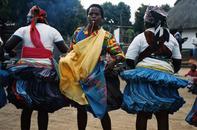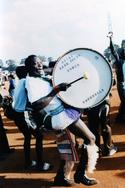Rich Musical Heritage
The Tsonga are well known for their rich musical heritage which is based on the playing of a wide variety of musical instruments. These can be divided into three categories: stringed, wind and percussion.

The most important stringed instruments include a notched vibrating bow 'xizambi', played by the musician holding the string, usually bark or twine, in his teeth, for resonance; a stick with resonators around it is rubbed up and down the notches of the bow, in time to the music. The xitendze is a bow with a calabash attached to it which acts as a resonator.
The mgangala, still played today, is a hollow reed bow plucked with the fingers, while the xipendana is a wire-stringed bow with a thickened handle plucked with a flat piece of metal. The wind instruments are: a cross flute 'xitiringo' with three holes, shepherd's pipes 'nanga', and an antelope horn trumpet 'mhalamhala'.

Percussion instruments consist of tambourines and drums. A flat round tambourine 'tsomane' is played by diviners to treat people possessed by evil spirits. Drums include ndzumba and xigubu, played at boys' and girls' initiation respectively, and ngoma, used at festive dances.
Two instruments, neither indigenous to the Tsonga, fall outside these categories: a hand piano with eight metal strips, about 10 centimetres - 4 inches long and 1 centimetre - 1/2 inch wide, fixed over a low saddle on a piece of wood, is played by stroking the metal strips; the other is a form of xylophone with a wooden keyboard and calabash resonators.
Tsonga music has changed since it was first recorded in the 1920s. Today it is possibly the most popular crossover music in the country, combining local and imported traditions.